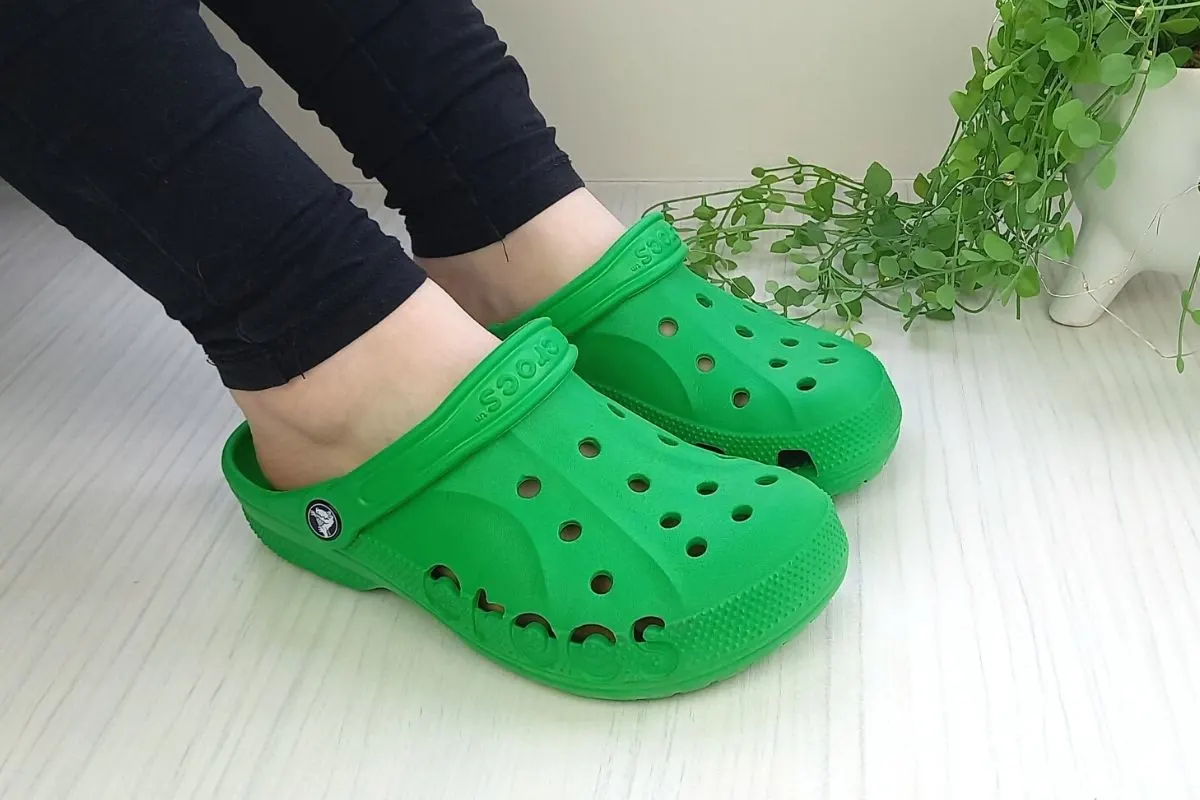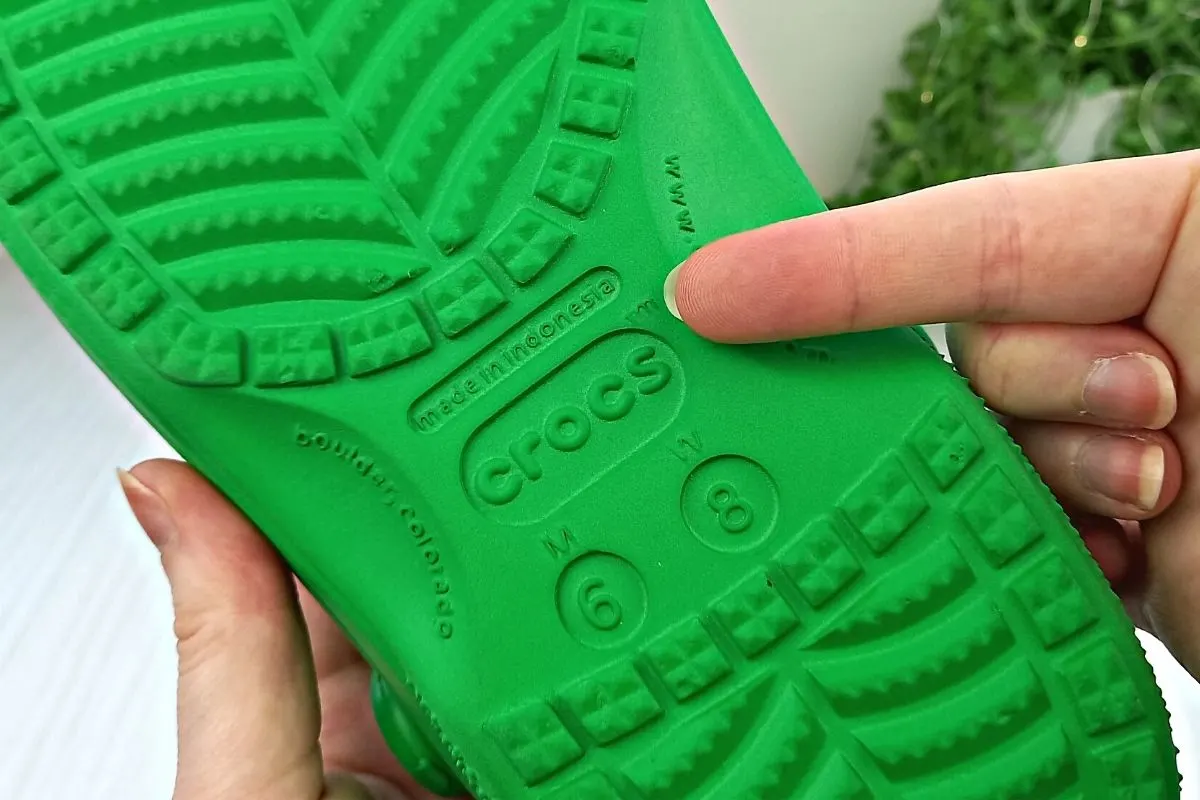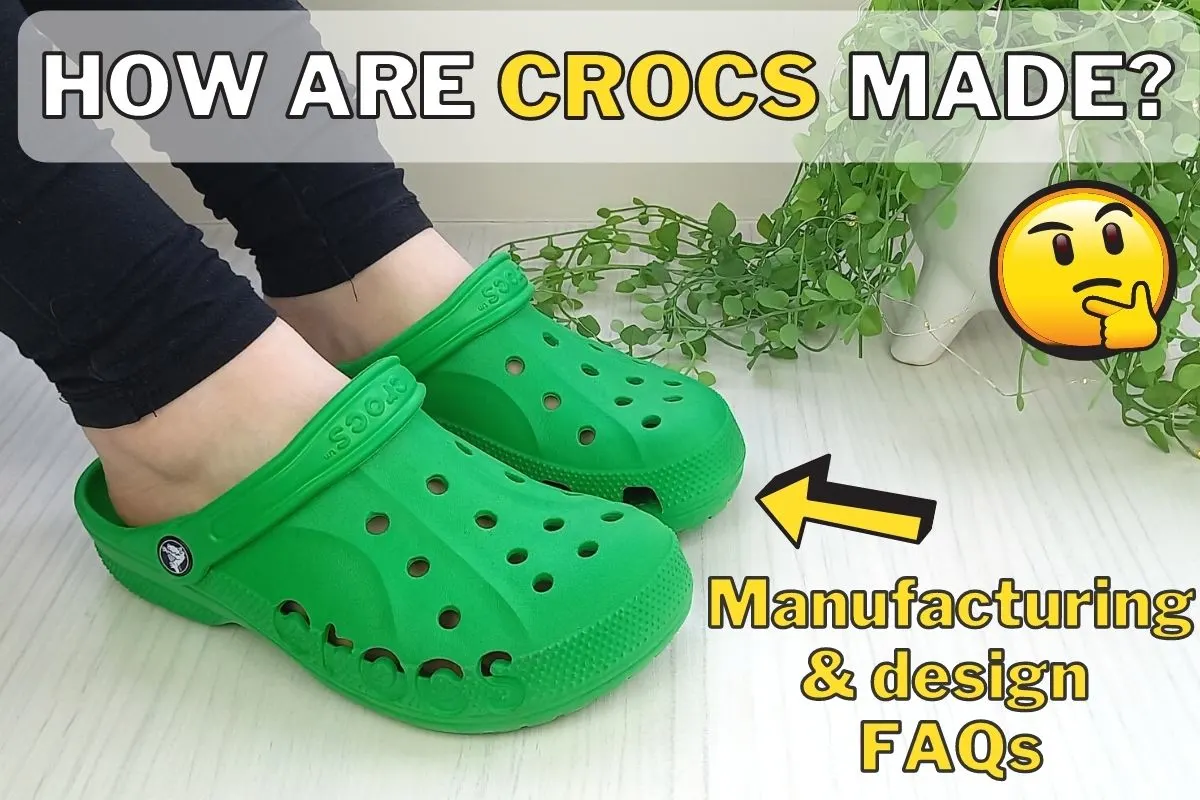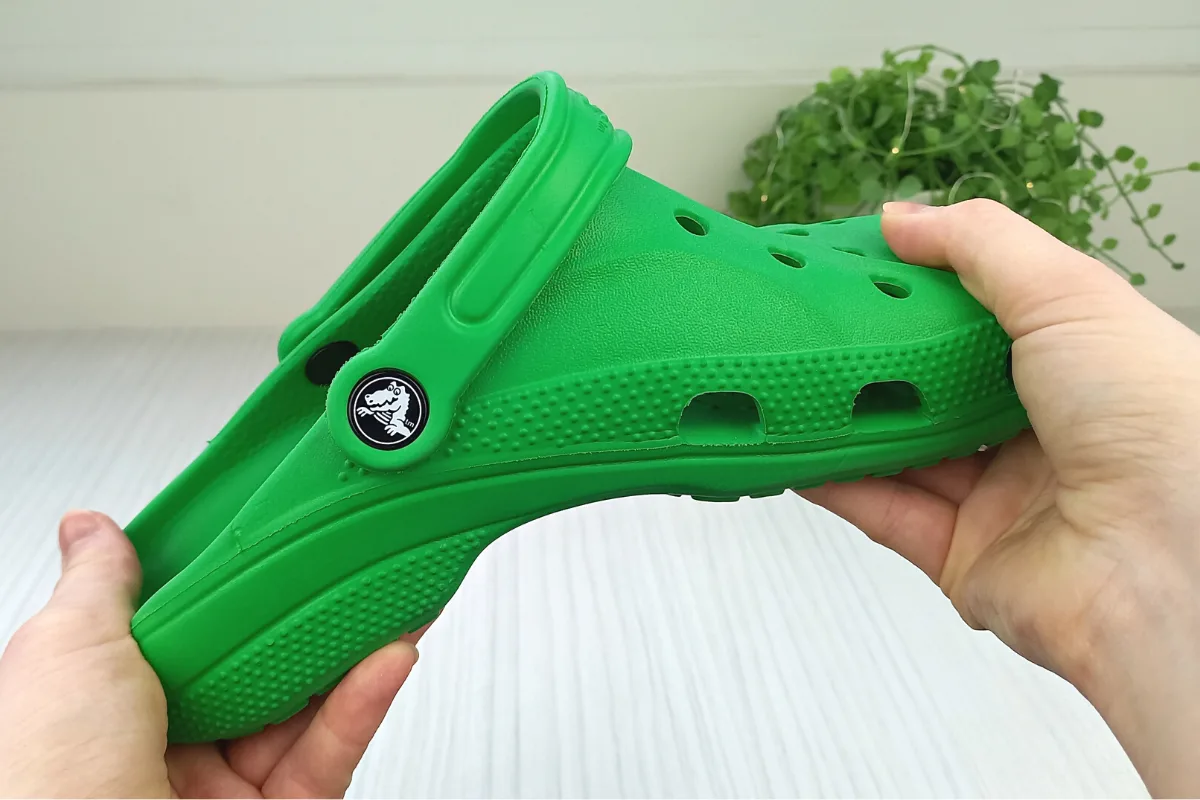As one of the most popular yet divisive shoe brands in the world there are many questions people have regarding Crocs footwear, including ‘where are Crocs made’?
Here is a frequently asked questions guide written by a long term fan and customer of the Crocs brand (focusing on where and how Crocs are made, including design and manufacturing FAQs).
Here’s a photo of me in my newest pair:

Some of the most common queries surrounding Crocs include the following:
- Where Are Crocs Made?
- How Are Crocs Made?
- Are Crocs Made In China?
- Are Crocs Made In Vietnam Fake?
- Where Are Real Crocs Made?
- What Is Croslite Made Of?
I have answered the above six questions in detail below, including photos, fun facts and more.
1. Where Are Crocs Made?
Crocs are currently being manufactured in the following countries:
- China,
- Bosnia,
- Vietnam,
- Argentina,
- Romania,
- Herzegovina, and
- Indonesia.
Crocs were previously being manufactured in the following countries but have closed their factories at the time of writing:
- The United States of America,
- Italy, and
- Mexico.
Crocs are considering opening a factory in the following country:
- India.
Here is a photo of my own pair of Crocs, showing the Indonesia manufacturing location printed onto the outsole:

You may also like: Best Crocs For Men, Two Guys Review (Color, Fit & Style)
History Of Crocs’ Manufacturing Operations
Although Crocs was founded by Lyndon Hanson and George Boedecker Jr. in 2002 in Colorado, the United States, with the first pairs of Crocs being manufactured in the United States, production swiftly transferred to cheaper markets.
Although Mexico was considered the largest manufacturer of Crocs in the world and was responsible for producing some of the larger variants of Crocs, the restructuring of the company in 2018 saw the closure of the factory in Mexico (as well as the closure of the factory in Italy).
The purpose of the restructuring seems to have been spurred on by the company’s fluctuating finances and stock price in 2014, which in turn led to Crocs seeking cheaper and more efficient manufacturing hubs.
Consequently, Crocs reported the elimination of 180 global jobs, 183 jobs in Colorado, closure of between 75 to 100 global stores, and the closure of underperforming product lines.
As such, the high costs of labor, access to raw materials, general labor practices, storage capacities, ease of trade route access, and the cost of delivering goods are some of the factors that may have contributed to the closure of Italy and Mexico’s factories.
This restructuring is, therefore, a clear indicator of why Crocs are choosing to manufacture their products in the aforementioned offshore countries, namely:
- The availability and cost of raw materials,
- The cost of labor and favorable labor laws,
- The cost of storage and transportation of goods.
The Availability And Cost Of Resources
It’s no coincidence that Crocs chose to outsource their manufacturing plants to offshore countries (such as China and Vietnam), which are known for their large production and storage of raw materials such as rubber, foam, and plastic.
Further to the above, these raw materials are produced in mass and housed in large warehouses close to factories within the industrial sectors of these countries.
This means that large quantities of these raw materials are readily accessible, in very large supply, and can be transported and bought for a much cheaper price, than say if they needed to be made, stored, and transported within the United States of America, where Crocs has its headquarters.
Unsurprisingly, this easy access to large quantities of affordable raw materials is one of the reasons why Crocs is looking to expand their manufacturing operations in India, along with other reasons such as favorable labor laws and cheap labor (see below.)
Cost Of Labor And Favorable Labor Laws
Countries like China, India, and Eastern Europe have become global manufacturing hubs and advertise themselves as the go-to jurisdictions for offshore outsourcing for companies that may have originally had manufacturing plants in their home countries.
The primary reason these countries have been identified as prime candidates for the manufacture of materials is due to their large, efficient labor forces, which have far more affordable wages as a result of preferable exchange rates, lower costs of living, and or the absence of stringent minimum wage laws and workers benefits.
Furthermore, these countries have invested heavily in automated machinery, skilled training, quality standard testing, large factories, and ample storage units to attract foreign investors looking for cheaper manufacturing hubs.
These countries also structure their work schedules, the laws around these schedules, carbon tax laws, and commercial operation legislation in such a way so as to favor large-scale manufacturing operations to maximize work time while minimizing overhead costs.
You may also like: Do Crocs Run Big or Small? – A Review (w/ photos)
Although this has led to some controversies regarding workers’ rights in offshore manufacturing hubs and concerns regarding the reduction of large-scale industries in developed countries such as the United States of America, it remains a viable method for Crocs and other companies to maximize production for lower costs.
Cost Of Storage And Transportation Of Goods
As mentioned above, these countries have developed their economy in such a way that mass storage of goods in a secure location is significantly cheaper than what other countries without these facilities may offer.
This storage and manufacturing capacity has inevitably led to these countries expanding their trade networks and exportation capabilities, meaning that countries like China and India have built upon their long-established reputation as large exporters of goods into the 21st century.
Another reason the aforementioned countries were selected is because of their close proximity to Crocs’ customer bases, namely Argentina in South America, China in Asia, and Eastern Europe’s networks throughout mainland Europe.
This also improves the speed and efficiency in which customers can issue complaints and suggestions to manufacturers, meaning a quicker turnaround time for the replacement/refund of any defective or poor-quality goods.
2. How Are Crocs Made?

From the design process to manufacturing and final quality control, Crocs are made in conjunction with both handmade craftsmanship and automation involving design software, standard factory machinery, and specialized EVA-foam injection molds.
Originally designed as foam clogs/boat shoes upon the acquisition of Foam Creations Inc, Crocs eventually designed and patented their own brand of foam resign known as Croslite (more on this below.)
It is this foam resin that has been described as an injection-molded EVA foam that uses complex machinery to combine the quick efficiency of injection molded shoes along with the software used to determine the design and color of the finished product.
Removal of the mold, finishing, quality checks, and the inclusion of a fixed strap are then typically performed by hand to make sure each finished pair of Crocs meets the industry standard.
However, there are slight deviations in the way. Crocs are made depending on their country of origin, which has led to some variations in quality.
However, these differences appear few and far between, as Crocs continues to streamline their operations along with their checks and balances.
For a visualization of the manufacturing process, the following is a link to a video on Crocs’ official YouTube page:
Crocs are made in various sizes and typically come as one solid shoe with a strap, and a single color scheme, with Crocs boasting upwards of 20 color options.
However, there are deviations to the norm and custom color schemes/limited addition Crocs, which are manufactured upon special request or as part of Crocs’ official marketing and design campaigns.
Another key feature of Crocs is the inclusion of 13 holes across the shoe’s main body. The purpose of these holes is to improve ventilation while wearing Crocs and provide a customization method through the use of Jibbitz charms.
Jibbitz charms are official Crocs merchandise. They are typically made from flexible rubber, foam, and plastic to allow wearers to customize their Crocs with these small charms (usually cartoon characters or stylized symbols.)
Some lesser-known Crocs products include the following (most of which are made via Croslite injection molds):
- Sandals,
- Flip flops,
- Slides,
- Flats,
- Wedges,
- Sneakers,
- Platforms,
- Socks,
- Loafers,
- Slipper,
- Boots, and
- A range of specifically designed work shoes (such as nursing and chef shoes.)
More traditional shoe variations of Crocs include their winter range of wooly liners known as the “Fuzzy Collection” and Crocs’ foray into the golf shoe market in 2008 upon their acquisition of Bite Footwear.
The purpose of this patented design, along with Croslite, is to produce shoes that are easy to wear, durable, and extremely comfortable. Consequently, Crocs have become a favorite for all activities, particularly with young children.
That being said, while some podiatrists recommend Crocs for their arch support, some believe their heel support is not sufficient for long-term everyday use, despite how comfortable they may be.
3. Are Crocs Made In China?
It is estimated that the number one manufacturing hub for Crocs is China and that roughly between 40 and 50 percent of all Crocs manufacturing (including other Crocs products such as Jibbitz) are manufactured in China.
As mentioned above, there are a number of reasons why Crocs, like other companies headquartered in developed countries, would look to outsource their manufacturing to offshore countries such as China.
Consequently, China’s ability to manufacture large quantities of goods on mass safely, efficiently, and affordably has led to China cornering the market as the number one manufacturer of Crocs and related Crocs products globally.
4. Are Crocs Made In Vietnam Fake?
Vietnam is one of the seven countries in the world that designs, manufactures, and distributes genuine Crocs products. However, that is not to say all supposed Crocs products made in Vietnam are real, as Vietnam has been known to be a source of counterfeit goods.
Although Vietnam has been known to produce counterfeit or grey goods for a host of product lines, including Crocs, there is actually a very good chance that Crocs made in Vietnam are legitimate.
This is because of America and China’s ongoing trade war, commercial disputes, and diplomatic disagreements.
Many companies are looking to restructure their companies and manufacturing plants away from China and into neighboring Vietnam.
Despite the need to downscale some operations in Vietnam due to recent outbreaks of the Delta variant of Covid-19, Crocs had committed to increasing their production of products from Vietnam to upwards of 70 percent by the end of 2021.
While it was unlikely that this target was reached, the steady decline in Covid-19 infections globally and the need to shift manufacturing away from China in the near future may very well see a rapid increase of Crocs production in Vietnam, thus further increasing the likelihood of the legitimacy of Crocs being made in the country.
5. Where Are Real Crocs Made?
Real Crocs products are designed, stored, and manufactured in China, Herzegovina, Bosnia, Romania, Argentina, Indonesia, and Vietnam, with India set to be the next manufacturing hub for Crocs.
Older/second-hand Crocs were made in Italy and Mexico before discontinuation in 2018.
Although the aforementioned countries all produce real Crocs, they are also known as being centers for the production and distribution of counterfeit and grey-market Crocs products.
In order to avoid being scammed into buying fake Crocs, here are some basic guidelines to follow:
- The Boulder, Colorado label is missing (note: separated by a comma, not a full stop),
- They are of a low quality/prone to causing discomfort,
- The Crocs logo itself is a sticker rather than an actual button,
- The labels do not conform with the detailed, accurate labels of genuine Crocs (look out for spelling mistakes, the absence of Croslite as a material, etc.),
- The sole of genuine Crocs have a detailed Crocs logo as well as size information and the Crocs official website (www.crocs.com), and
- Genuine Crocs are sold in an official transparent or white branded bag, not a cardboard box.
For a full guide on spotting fake Crocs, I have a dedicated post with photos here: How To Spot Fake Crocs – 10 Differences (Photos)
6. What Is Croslite Made Of?
Croslite is the primary, patented material that makes up the majority of Crocs products. Croslite is a foam resin material that is made from a polymer known as ethylene-vinyl acetate.
Although EVA is not plastic, it mirrors some characteristics of soft plastic, such as being an elastomeric material; unfortunately, this means that EVA is also non-recyclable.
Croslite is a key component in Crocs due to its ability to absorb shock, its durability, and its water-resistant qualities.

That being said, the durability of Croslite is tested when placed in direct sunlight for extended periods of time or when exposed to significant heat.
For these reasons, Crocs should be stored in a cool, shaded space, preferably in the Crocs branded bag they were purchased in.
In conclusion, the properties of Croslite that make Crocs such a popular product can be summarized as follows:
- Available in a variety of colors,
- Lightweight,
- Flexible,
- Durable,
- Water-resistant,
- Excellent shock absorption and comfort,
- Malleable to one’s feet,
- Slip resistant,
- Resistant to ultra-violet light,
- Antimicrobial, and
- Displays moderate insulation properties.
Conclusion
Whether you love or hate these divisive shoes, there’s no denying that Crocs have been successful in creating a recognizable and beloved brand through unique designs and quality manufacturing.
Thank you for reading this post, I hope you feel like you have learned some useful information about the Crocs brand to inform any future purchases.
For more Crocs content, check out:
Are Crocs Non Slip? A Review and Model Breakdown
How to Clean Crocs – Ultimate Guide and FAQs
Are Crocs Comfortable? – Ultimate Q&A Review Guide


Lorna is a footwear geek and the founder of Wearably Weird. She created a YouTube channel in 2021 for fellow footwear fanatics, dedicated to detail-rich footwear reviews and info. She has a fashion media qualification (awarded in 2011).
